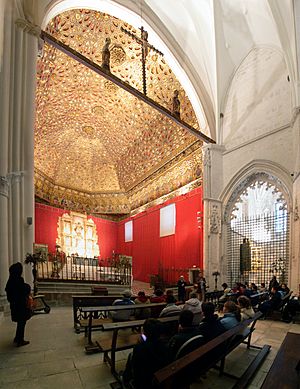Royal Convent of Santa Clara facts for kids
The Royal Convent of Santa Clara is a special building in Tordesillas, Spain. It is a nunnery, which is a place where nuns live and pray. King Pedro of Castile started this convent in 1363. Today, a group called the Patrimonio Nacional takes care of it. This group looks after many important historical places in Spain.
The convent is famous for its unique style of building, called Mudéjar architecture. This style mixes Christian and Islamic art. You can see this especially in the church's ceiling. The ceiling has a special type of decoration called artesonado. This means it is made of beautiful wooden panels. These panels are often carved into amazing geometric shapes.
Contents
A Look at History
The Royal Convent of Santa Clara has a long and interesting past. It was built a very long time ago, in the year 1363. This was during the time of King Pedro of Castile. He was also known as Pedro the Cruel. He wanted to create a peaceful place for nuns to live. The nuns who live here are part of a group called the Poor Clares. They follow the teachings of Saint Clare of Assisi.
Amazing Architecture
One of the most exciting things about the convent is its architecture. It shows the Mudéjar style. This style was popular in Spain for many years. It came from a mix of cultures. Christian builders learned many techniques from Islamic artists. They used these ideas to create stunning buildings.
What is Mudéjar Architecture?
Mudéjar architecture is a special way of building. It uses materials like brick, wood, and plaster. It often features beautiful patterns. These patterns can be found on walls, ceilings, and floors. They often include stars, polygons, and other geometric shapes. These designs are very detailed and look like puzzles.
The Artesonado Ceiling
The ceiling inside the church is a great example of Mudéjar art. It is an artesonado ceiling. Imagine a giant wooden puzzle above your head! These ceilings are made from many small pieces of wood. Each piece is carefully cut and fitted together. They form intricate patterns. Sometimes, these patterns look like stars or honeycombs. They are truly works of art.
See also



